Spot-checking is a way of discovering which algorithms perform well on your machine learning problem. You cannot know which algorithms are best suited to your problem beforehand. You must trial a number of methods and focus attention on those that prove themselves the most promising. In this chapter you will discover six machine learning algorithms that you can use when spot-checking your regression problem in Python with scikit-learn. After completing this lesson you will know:
- How to spot-check machine learning algorithms on a regression problem.
- How to spot-check four linear regression algorithms
- How to spot-check three nonlinear regression algorithms
1.1 Algorithms Overview
In this lesson we are going to take a look at seven regression algorithms that you can spot-check on your dataset. Starting with four linear machine learning algorithms:
- Linear Regression
- Ridge Regression
- LASSO Linear Regression
- Elastic Net Regression
Then looking at three nonlinear machine learning algorithms:
- k-Nearest Neighbors
- Classification and Regression Trees
- Support Vector Machines.
Each recipe is demonstrated on the Boston House Price dataset. This is a regression problem where all attributes are numeric. A test harness with 10-fold cross validation is used to demonstrate how to spot-check each machine learning algorithm and mean squared error measures are used to indicate algorithm performance. Note that mean squared error values are inverted (negative). This is a quirk of the cross_val_score() function used that requires all algorithm metrics to be sorted in ascending order (larger value is better). The recipes assume that you know about each machine learning algorithm and how to use them. We will not go into the API or parameterization of each algorithm.
1.2 Linear Machine Learning Algorithms
This section provides examples of how to use four different linear machine learning algorithms for regression in Python with scikit-learn.
1.2.1 Linear Regression
Linear regression assumes that the input variables have a Gaussian distribution. It is also assumed that input variables are relevant to the output variable and that they are not highly correlated with each other (a problem called collinearity). You can construct a linear regression model using the LinearRegression class.
# Example of the linear regression algorithm
# Linear Regression
from pandas import read_csv
from sklearn.model_selection import KFold
from sklearn.model_selection import cross_val_score
from sklearn.linear_model import LinearRegression
filename = 'housing.csv'
names = ['CRIM','ZN','INDUS','CHAS','NOX','RM','AGE','DIS','RAD','TAX','PTRATIO','B','LSTAT','MEDV']
dataframe = read_csv(filename,names=names)
array = dataframe.values
X = array[:,0:8]
Y = array[:,8]
num_folds = 10
kfold = KFold(n_splits = 10 , random_state=7, shuffle=True)
model = LinearRegression()
scoring = 'neg_mean_squared_error'
results = cross_val_score(model, X, Y, cv=kfold, scoring=scoring)
print(results.mean())Running the example provides a estimate of mean squared error.

1.2.2 Ridge Regression
Ridge regression is an extension of linear regression where the loss function is modified to minimize the complexity of the model measured as the sum squared value of the coefficient values (also called the L2-norm). You can construct a ridge regression model by using the Ridge class.
# Example of the ridge regression algorithm
# Ridge Regression
from pandas import read_csv
from sklearn.model_selection import KFold
from sklearn.model_selection import cross_val_score
from sklearn.linear_model import Ridge
filename = 'housing.csv'
names = ['CRIM','ZN','INDUS','CHAS','NOX','RM','AGE','DIS','RAD','TAX','PTRATIO','B','LSTAT','MEDV']
dataframe = read_csv(filename, names=names)
array = dataframe.values
X = array[:,0:13]
Y = array[:,13]
num_folds = 10
kfold = KFold(n_splits = 10, random_state=7, shuffle=True)
model = Ridge()
scoring = 'neg_mean_squared_error'
results = cross_val_score(model, X, Y, cv=kfold, scoring=scoring)
print(results.mean())Running the example provides an estimate of the mean squared error.
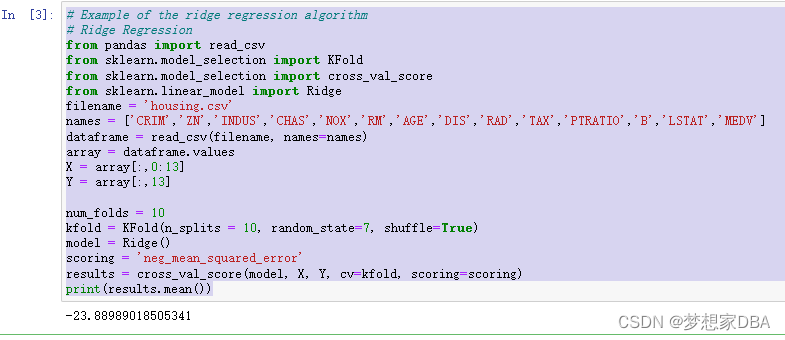
1.2.3 LASSO Regression
The Least Absolute Shrinkage and Selection Operator (or LASSO for short) is a modification of linear regression, like ridge regression, where the loss function is modified to minimize the complexity of the model measured as the sum absolute value of the coefficient values(also called the L1-norm), You can construct a LASSO model by using the lasso class.
# Lasso Regression
from pandas import read_csv
from sklearn.model_selection import KFold
from sklearn.model_selection import cross_val_score
from sklearn.linear_model import Lasso
filename = 'housing.csv'
names = ['CRIM','ZN','INDUS','CHAS','NOX','RM','AGE','DIS','RAD','TAX','PTRATIO','B','LSTAT','MEDV']
dataframe = read_csv(filename, names=names)
array = dataframe.values
X = array[:,0:13]
Y = array[:,13]
num_folds = 10
kfold = KFold(n_splits = 10, random_state=7, shuffle=True)
model = Lasso()
scoring = 'neg_mean_squared_error'
results = cross_val_score(model, X, Y, cv=kfold, scoring=scoring)
print(results.mean())Running the example provides an estimate of the mean squared error.
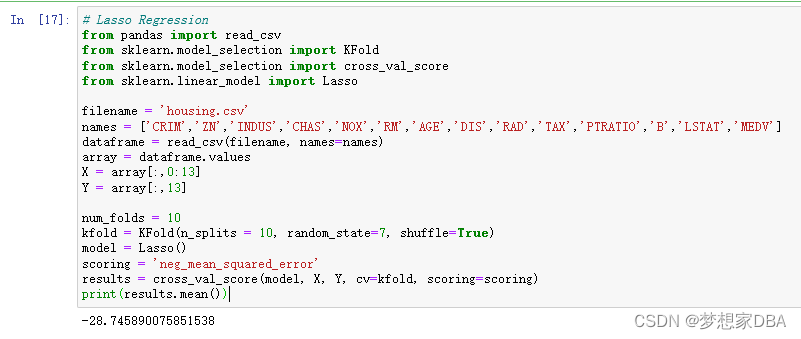
1.2.4 ElasticNet Regression
ElasticNet is a form of regularization regression that combines the properties of both Ridge Regression and LASSO regression. It seeks to minimize the complexity of the regression model (magnitude and number of regression coefficients) by penalizing the model using both the L2-norm (sum squared coefficient values) and the L1-norm (sum absolute coefficient values). You can construct an ElasticNet model using the ElasticNet class.
# Example of the ElasticNet regression algorithm
# ElasticNet Regression
from pandas import read_csv
from sklearn.model_selection import KFold
from sklearn.model_selection import cross_val_score
from sklearn.linear_model import ElasticNet
filename = 'housing.csv'
names = ['CRIM','ZN','INDUS','CHAS','NOX','RM','AGE','DIS','RAD','TAX','PTRATIO','B','LSTAT','MEDV']
dataframe = read_csv(filename, names=names)
array = dataframe.values
X = array[:,0:13]
Y = array[:,13]
kfold = KFold(n_splits=10, random_state=7, shuffle=True)
model = ElasticNet()
scoring = 'neg_mean_squared_error'
results = cross_val_score(model, X, Y, cv=kfold, scoring=scoring)
print(results.mean())Running the example provides an estimate of the mean squared error.
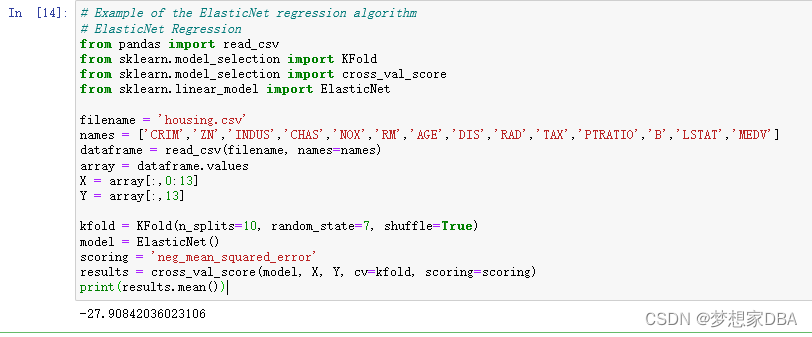
1.3 Nonlinear Machine Learning Algorithms
This section provides examples of how to use three different nonlinear machine learning algorithms for regression in Python with scikit-learn.
1.3.1 K-Nearest Neighbors
The k-Nearest Neighbors algorithm (or KNN) locates the k most similar instances in the training dataset for a new data instance. From the k neighbors, a mean or median output variable is taken as the prediction. Of note is the distance metric used (the metric argument). The Minkowski distance is used by default, which is a generalization of both the Euclidean distance (used when all inputs have the same scale) and Manhattan distance (for when the scales of the input variables differ). You can construct a KNN model for regression using the KNeighborsRegressor class.
# Example of the KNN regression algorithm
# KNN algorithm
from pandas import read_csv
from sklearn.model_selection import KFold
from sklearn.model_selection import cross_val_score
from sklearn.neighbors import KNeighborsRegressor
filename = 'housing.csv'
names = ['CRIM','ZN','INDUS','CHAS','NOX','RM','AGE','DIS','RAD','TAX','PTRATIO','B','LSTAT','MEDV']
dataframe = read_csv(filename, names=names)
array = dataframe.values
X = array[:,0:13]
Y = array[:,13]
kfold = KFold(n_splits=10, random_state=7, shuffle=True)
model = KNeighborsRegressor()
scoring = 'neg_mean_squared_error'
results = cross_val_score(model, X, Y, cv=kfold, scoring=scoring)
print(results.mean())Running the example provides an estimate of the mean squared error.
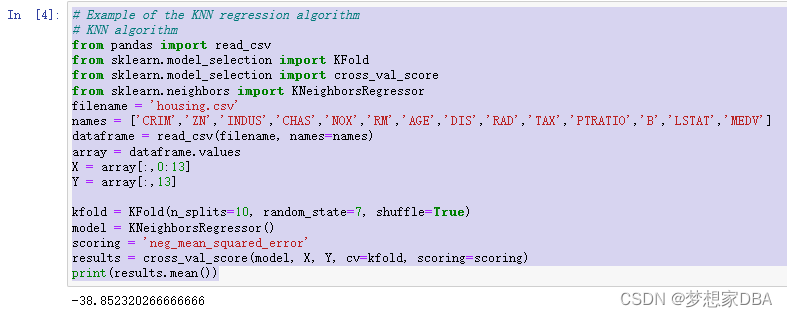
1.3.2 Classification and Regression Tree
Decision trees or the Classification and Regression Trees (CART as they are known) use the training data to select the best points to split the data in order to minimize a cost metric. The default cost metric for regression decision trees is the mean squared error, specified in the criterion parameter. You can create a CART model for regression using the DecisionTreeRegressor class.
# Example of the CART regression algorithm
# Decision Tree Regression
from pandas import read_csv
from sklearn.model_selection import KFold
from sklearn.model_selection import cross_val_score
from sklearn.tree import DecisionTreeRegressor
filename = 'housing.csv'
names = ['CRIM','ZN','INDUS','CHAS','NOX','RM','AGE','DIS','RAD','TAX','PTRATIO','B','LSTAT','MEDV']
dataframe = read_csv(filename,names=names)
array = dataframe.values
X = array[:,0:13]
Y = array[:,13]
num_folds = 10
kfold = KFold(n_splits=10, random_state=7, shuffle=True)
model = DecisionTreeRegressor()
scoring = 'neg_mean_squared_error'
results = cross_val_score(model, X, Y, cv=kfold, scoring=scoring)
print(results.mean())Running the example provides an estimate of the mean squared error.
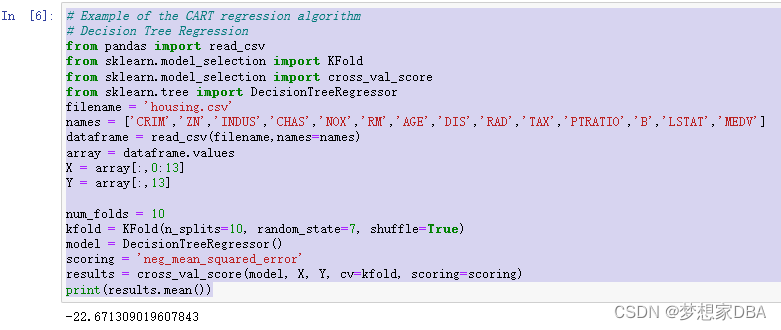
1.3.3 Support Vector Machines
Support Vector Machines (SVM) were developed for binary classification. The technique has been extended for the prediction real-valued problems called Support Vector Regression (SVR). Like the classification example, SVR is built upon the LIBSVM library. You can create an SVM model for regression using the SVR class.
# SVM Regression
from pandas import read_csv
from sklearn.model_selection import KFold
from sklearn.model_selection import cross_val_score
from sklearn.svm import SVR
filename = 'housing.csv'
names = ['CRIM','ZN','INDUS','CHAS','NOX','RM','AGE','DIS','RAD','TAX','PTRATIO','B','LSTAT','MEDV']
dataframe = read_csv(filename,names=names)
array = dataframe.values
X = array[:,0:13]
Y = array[:,13]
num_folds = 10
kfold = KFold(n_splits=10, random_state=7, shuffle=True)
model = SVR()
results = cross_val_score(model, X, Y, cv=kfold, scoring=scoring)
print(results.mean())Running the example provides an estimate of the mean squared error.
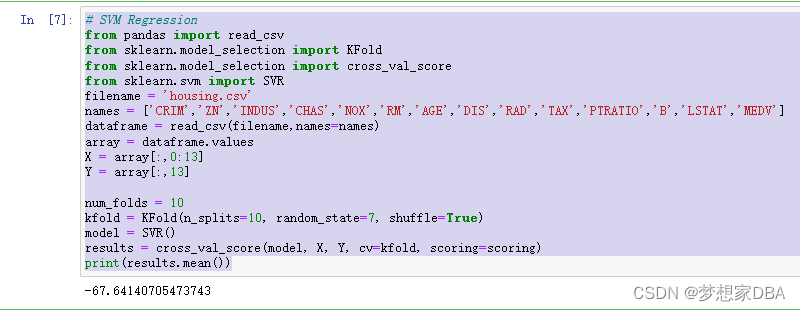
1.4 Summary
In this chapter you discovered how to spot-check machine learning algorithms for regression problems in Python using scikit-learn. Specifically, you learned about four linear machine learning algorithms: Linear Regression, Ridge Regression, LASSO Linear Regression and Elastic Net Regression. You also learned about three nonlinear algorithms: k-Nearest Neighbors, Classification and Regression Trees and Support Vector Machines.
最后
以上就是谨慎纸鹤最近收集整理的关于How to Spot-Check Regression Algorithms的全部内容,更多相关How内容请搜索靠谱客的其他文章。








发表评论 取消回复